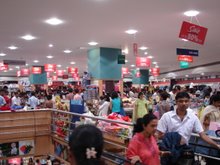Retail revolution begins
The retail game has barely begun, and the new players are already rewriting the rules. The chain stores are buying at the farm-gate, perhaps to ensure adequacy of supply, and in the process making it more difficult for those who depend for their supply on goods that reach wholesale markets. At the same time, the big manufacturers of branded consumer goods sense that the chain stores will leverage their promise of large volumes to squeeze them on prices, and they have decided therefore to give a helping hand to the neighbourhood stores, the idea being to shore these up as an alternative distribution channel. Some of these moves will help farmers, others will help consumers: some manufacturers who have so far exploited the lack of bargaining power on the part of the individual retailer, will have to accept lower margins; and some neighbourhood shops may cease to be independent entities and choose to leverage the advantage of their location by taking on the identity of franchisees and attaching themselves to the chain stores.Competition brings with it change and, as India's retail sector gets more organised, change will remain the order of the day. As there are winners, so will there be losers. But it is safe to say that the vast majority will be gainers out of this process—as is already evident. The entry of private companies into the wheat trade last year forced prices to go up, benefiting millions of farmers. Reliance Retail is able to sell many products at prices that are significantly lower than those charged by neighbourhood stores—benefiting consumers and helping to fight inflation. Bharti has set up a model farm outside Ludhiana and has promised farmers an assured return. These and other companies are getting organised for tapping export markets, setting up cold chains and investing in logistics. All of that should yield significant efficiency gains, which will have spread-effects in the economy as a whole. The biggest benefit will be that producers will get better price signals and therefore invest in improving yields and production—both of which should help control inflation and also deliver surpluses for export markets. An equally big benefit will flow to retail consumers. These constitute only one part of the series of changes affecting consumer goods. There is the introduction of futures trading, for more efficient price discovery—and this will certainly help farmers who usually do not know, at sowing time, what prices will prevail when their harvest becomes ready. There is also the investment in food processing that will get encouragement as companies figure out that this holds the key to evening out the ebb and flow of the food cycle—abundant supply and low prices at harvest time, and highprices amid general scarcity in the lean season. Companies that are eager to develop exportable supplies will also be encouraged to introduce new technology and work with farmers to improve yields as also varieties. However, change will cause stress in some quarters. The wholesale price index might show an unwelcome surge because this tracks prices in the wholesale markets—which may no longer be the best indicator if more supplies are being booked at the farm-gate. The government may find it difficult to source low-cost supplies for the public distribution system (as happened last year with wheat), and this could lead to higher subsidies being paid out of the exchequer. Some neighbourhood stores may also find the new level of competition unwelcome, and their owners might decide to do other things—but that should be regarded as a necessary concomitant of change as the retail system gets more organised and efficient. What policy-makers should track is the net gain or loss to the system, and leave matters well alone if the net outcome is largely positive.
courtesy:Business Standard
For more on Retail India visit www.retailindia.tv


No comments:
Post a Comment